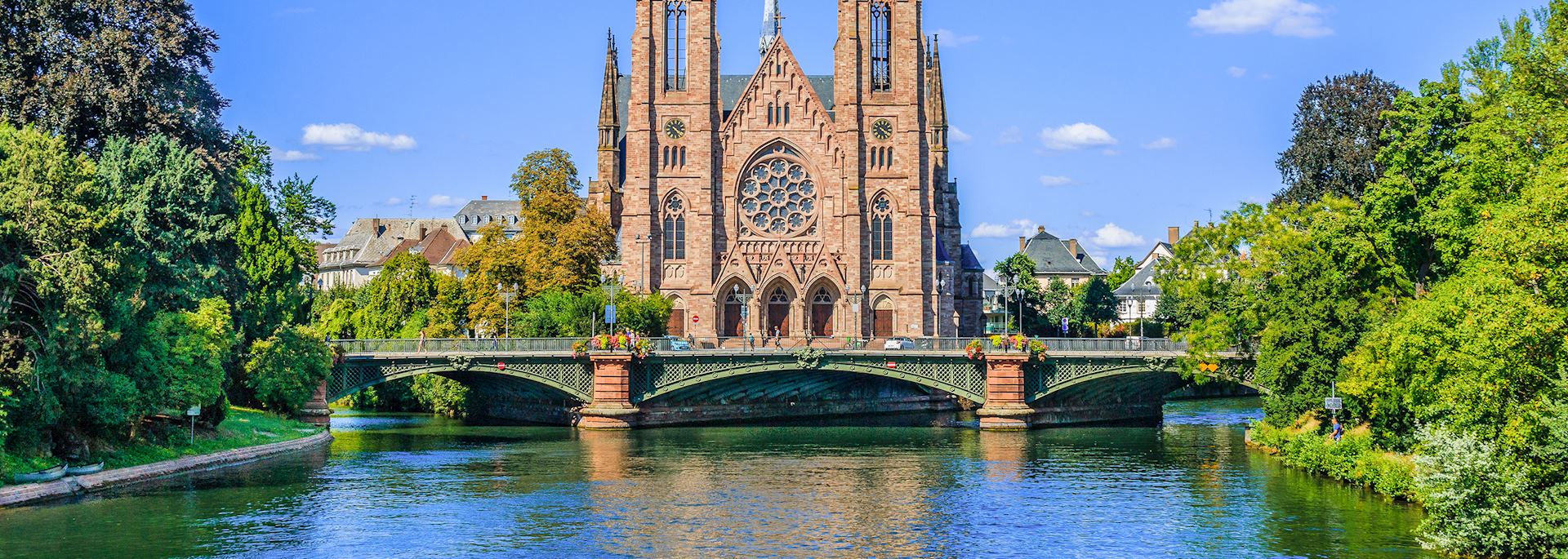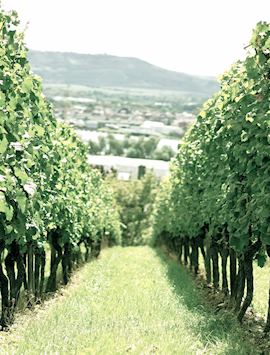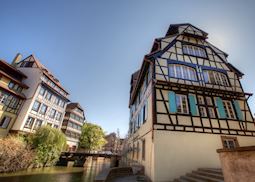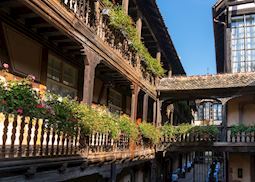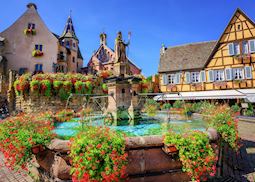Jump to:
Strasbourg sits squarely at the crossroads of France and Germany, a geographical vantage point that has made it the official home of the European Parliament. The capital city of France's Alsace region (formally known as Grand Est), simply walking the streets of Strasbourg gives you a vivid sense of how Germanic and Gallic cultures rub alongside each other companionably here.
Though you’re in France, residents might chat to you in either French or German. Haussmann-tinged apartments with wrought-iron balconies sit next to buildings that could have been lifted straight out of the Black Forest. France’s alfresco café culture is alive and well, but you’ll also find microbreweries creating Alsatian beers as well as down-to-earth winstubs (taverns) serving hearty Germanic fare. And, while we’re on the subject of food and drink, note that Strasbourg makes an excellent staging post for exploring the Alsatian wine route.
Things to see and do in Strasbourg
The European Parliament
The glass-and-steel hollow tower of the European Parliament, along with the other contemporary edifices that make up Strasbourg’s European institutions, are a 30-minute riverside walk from the city’s central district. Despite their imposing structures, most parliamentary work takes place in Brussels, though official voting is always held here.
Central Strasbourg
The European Parliament buildings aside, the heart of Strasbourg is, in fact, incredibly historic and even storybook-like in parts. The city sits right on the Rhine River, giving parts of it the look of waterside Amsterdam, while other streets are crammed with medieval half-timbered houses, their windows decorated with jaunty flower boxes.
Elsewhere, artfully ramshackle bars, chic boutiques, and stately, Parisian-esque mansions line the streets. And, for a real touch of fairy-tale whimsy, you might notice white storks nesting on the roofs of buildings. They’re an important folk-tale emblem of the town, reported to bring good weather as well as newborns.
Petite France, Strasbourg’s historic Alsatian quarter
The most photogenic part of the city is arguably this former tanners’ district, where — contrary to what the name suggests — the ambience is very much old-world Alsace. Black-and-white timber-framed houses huddle together on winding, cobbled lanes. Winstubs — traditional Alsatian taverns — proudly advertise their house specialty, choucroute garnie (sauerkraut served with bratwurst and smoked meats). For a more casual snack, however, you can pick up a slice of flammekueche, or tarte flambée — a flat, pizza-like slab laden with fried onions, lardons, and melted cheese.
It’s a great place to stroll around, weaving your way over the weirs and locks of the Ill River, which rushes around and through the quarter.
Strasbourg’s Christmas markets
In early December two of the city’s main squares come alive with German-style Christmas markets, called Christkindelsmärik. The air is full of the heady spices of glühwein (mulled wine) and gingerbread, and the scent of chocolate-smeared waffles. And that’s just the food — markets also sell handicrafts and Christmas decorations.
Made up of rows of wooden cabins decked out in fairy lights, the Christmas markets are a real festive experience, and — allegedly — a historic fixture, too: they claim to be the oldest Christmas markets held on French soil.
Outside the city
Looking further afield, the city is connected by direct TGV fast trains to Switzerland, Luxembourg, plus many French and German cities, making it easy to include in all kinds of Europe itineraries.
The Alsatian Wine Route
Medieval castles, gently rolling hills, and villages made up of half-timbered buildings make up the Alsatian Wine Route, the oldest in France. The villages are the soul of the route: rather than stopping at vineyards for tastings, you’ll call into wineries based in villages. This quirk is a result of the rather turbulent identity-changing and border disputes that have historically occurred between France and Germany.
You could journey the whole 170 km (105 mile) route, from Marlenheim in the north to Thann in the south, or pick selections of it. Either way, you can expect to explore rieslings, gewürztraminers, and even the local sparkling wine, the crémant d’Alsace.
Best time to visit Strasbourg
Spring and summer lend themselves to relaxed strolls by the Rhine, and it’s when you’ll see the city’s flower boxes in full bloom. However, another good time to visit Strasbourg is December, when the Christmas markets roll into town and the whole place is lit up with festive cheer.
who's been there
-
617-223-4521617-223-4762
- Make an inquiry
Suggested itinerary featuring Strasbourg
This sample itinerary will give you an idea of what is possible when you travel in Strasbourg, and showcases routes we know work particularly well. Treat this as inspiration, because your trip will be created uniquely by one of our specialists.
Places near Strasbourg
- Colmar 40 miles away
- Alsace 64 miles away
- Reims 175 miles away
- Chamonix 195 miles away
- Annecy 200 miles away
- Talloires 203 miles away
- Lyon 239 miles away
- Paris 248 miles away
- Arras 253 miles away
- Lille 254 miles away
- ¸éłóĂ´˛Ô±đ-´ˇ±ô±č±đ˛ő 260 miles away
- Château de Chambord 296 miles away
- Château de Cheverny 300 miles away
Photos of Strasbourg
Accommodation choices for Strasbourg
We've selected a range of accommodation options for when you visit Strasbourg. Our choices usually come recommended for their character, facilities and service or location. Our specialists always aim to suggest properties that match your preferences.
-
![The timbered exterior of HĂ´tel & Spa RĂ©gent Petite France Strasbourg]()
HĂ´tel & Spa RĂ©gent Petite France
Strasbourg -
![The dining area]()
HĂ´tel les Haras
Strasbourg -
![The charming exterior]()
HĂ´tel Cour du Corbeau Strasbourg-MGallery
Strasbourg
Ideas for experiencing Strasbourg
Our specialists seek out authentic ways to get to know the places that could feature in your trip. These activities reflect some of the experiences they've most enjoyed while visiting Strasbourg, and which use the best local guides.
-
Gourmet walking tour of Strasbourg ![Quaint timbered houses of Petite France in Strasbourg]()
Gourmet walking tour of Strasbourg
Gourmet walking tour of Strasbourg
French and German influences combine in Alsace to create a distinctive cuisine. This privately guided walking tour through Strasbourg gives you a good introduction to the region’s traditional dishes, including sauerkraut, white asparagus, effervescent local wines, and spiced breads.
View details -
Pearls of Alsace ![Eguisheim, France]()
Pearls of Alsace
Pearls of Alsace
Get to know Alsace on this full-day private tour. You’ll thoroughly explore the region, which is known for its distinctive French-Germanic character. Experience the half-timbered houses of Colmar, small medieval villages, a winding wine route, and a turreted castle on a hill.
View details
